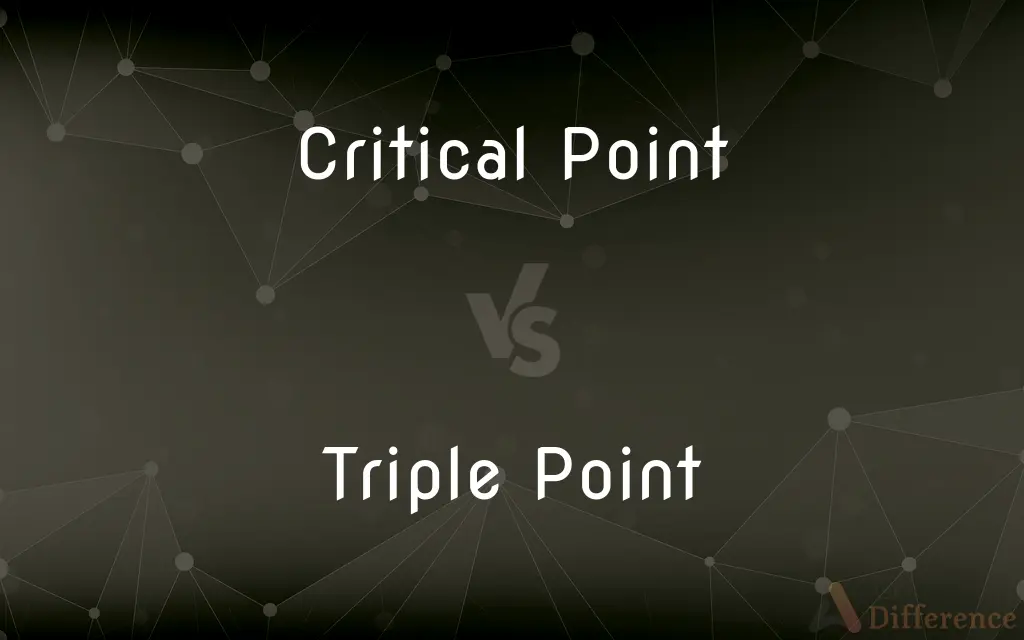Critical Point vs. Triple Point — What's the Difference?
By Tayyaba Rehman — Published on November 28, 2023
Critical Point is where a substance's liquid and gas phases coexist uniquely, while Triple Point is where its solid, liquid, and gas phases coexist simultaneously.

Difference Between Critical Point and Triple Point
Table of Contents
ADVERTISEMENT
Key Differences
Critical Point is a significant concept in thermodynamics, referring to the temperature and pressure at which a substance's liquid and gas phases become indistinguishable. When a substance reaches its Critical Point, it can no longer be liquefied by increasing pressure, and it exists in a state known as the supercritical fluid. This supercritical fluid has properties between those of liquids and gases, showcasing the blend of features from both phases.
Triple Point, in contrast, represents a unique condition where all three states of a substance – solid, liquid, and gas – coexist in equilibrium. For a given substance, the Triple Point is marked by a specific temperature and pressure. It acts as a reference point in thermodynamics, particularly in the Kelvin scale, where the Triple Point of water is defined as 273.16 K, ensuring consistent temperature measurements.
While the Critical Point focuses on the convergence of liquid and gas states, the Triple Point emphasizes the coexistence of all three fundamental states of matter. Both points offer invaluable insights into the properties and behaviors of substances under varying conditions.
Understanding the distinction between the Critical Point and Triple Point is essential for various scientific and industrial applications. For instance, the Critical Point informs processes like supercritical fluid extraction, while the Triple Point is foundational in calibrating temperature scales.
Comparison Chart
Definition
Point where liquid and gas phases become indistinguishable.
Point where solid, liquid, and gas phases coexist.
ADVERTISEMENT
States of Matter Involved
Liquid and Gas
Solid, Liquid, and Gas
Significance
Transition to supercritical fluid state.
Coexistence of three states in equilibrium.
Application
Supercritical fluid extraction, etc.
Calibration of temperature scales, etc.
Dependency
Affected by substance's properties.
Unique for each substance and used as a reference.
Compare with Definitions
Critical Point
A blend of liquid and gas properties.
Supercritical fluids, beyond the Critical Point, dissolve materials like both liquid and gas.
Triple Point
Specific temperature and pressure where three phases coexist.
At its Triple Point, water exists as ice, liquid, and vapor simultaneously.
Critical Point
Transition to a supercritical fluid state.
Beyond the Critical Point, substances enter a supercritical state.
Triple Point
Ensures consistent temperature measurements.
Using water's Triple Point ensures uniformity in temperature calibrations.
Critical Point
Temperature and pressure where liquid and gas merge.
At the Critical Point, water can't be distinguished as a liquid or gas.
Triple Point
Unique equilibrium state for substances.
Each substance has a distinct Triple Point based on its properties.
Critical Point
Unique to each substance based on molecular interactions.
The Critical Point of carbon dioxide differs from that of water.
Triple Point
Represents pure substance's state stability.
The Triple Point helps in understanding the stability of states under specific conditions.
Critical Point
Point where increasing pressure doesn't liquefy the gas.
After reaching the Critical Point, gases resist liquefaction regardless of pressure.
Triple Point
Reference point in thermodynamics.
The Triple Point of water is foundational for the Kelvin temperature scale.
Common Curiosities
Why is the Critical Point significant?
It denotes the transition to a supercritical fluid state with blended properties of liquids and gases.
What is a Critical Point?
The Critical Point is where a substance's liquid and gas phases become indistinguishable.
What happens at the Triple Point of a substance?
All three states of matter for that substance coexist in equilibrium.
Are the Critical and Triple Points the same for all substances?
No, they are unique for each substance based on its molecular properties.
How does the Triple Point differ from the Critical Point?
The Triple Point is where a substance's solid, liquid, and gas phases coexist simultaneously.
Can substances exist beyond their Critical Point?
Yes, they exist as supercritical fluids beyond their Critical Point.
Is the Triple Point important for all substances?
Yes, it provides insights into the equilibrium and stability of a substance's states under specific conditions.
Is the Triple Point always at the same pressure and temperature?
No, it varies for each substance.
How is the Triple Point used in temperature calibration?
It acts as a reference, especially with the Triple Point of water defining 273.16 K in the Kelvin scale.
What are supercritical fluids?
Fluids that exist beyond their Critical Point, showing properties between liquids and gases.
Can the Triple Point be observed in everyday life?
It's not common in everyday scenarios but can be observed under specific controlled conditions in laboratories.
Why can't gases be liquefied beyond their Critical Point?
Because the distinction between the liquid and gas phases disappears beyond this point.
Why is the Critical Point crucial for industrial applications?
It informs processes like supercritical fluid extraction, which is used in various industries.
Which state of matter is not involved in the Critical Point?
The solid state is not involved; the Critical Point pertains to the liquid and gas states.
Can the Triple Point be altered?
No, it's a unique characteristic of each pure substance.
Share Your Discovery

Previous Comparison
Absorbance vs. Fluorescence
Next Comparison
Saka Samvat vs. Vikram SamvatAuthor Spotlight
Written by
Tayyaba RehmanTayyaba Rehman is a distinguished writer, currently serving as a primary contributor to askdifference.com. As a researcher in semantics and etymology, Tayyaba's passion for the complexity of languages and their distinctions has found a perfect home on the platform. Tayyaba delves into the intricacies of language, distinguishing between commonly confused words and phrases, thereby providing clarity for readers worldwide.
















































